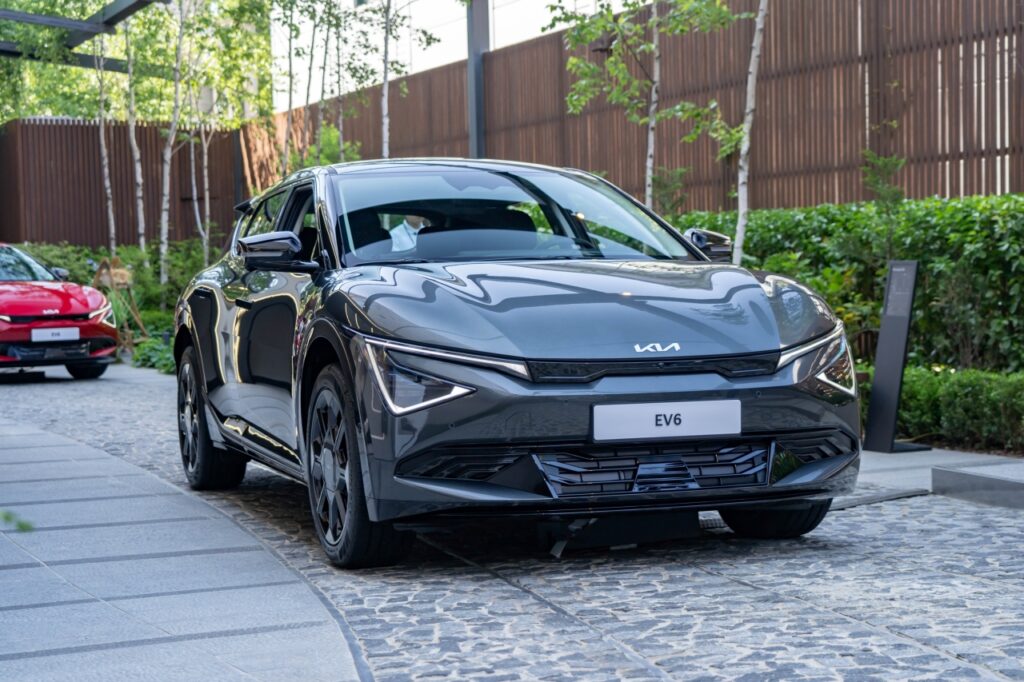
The EV6, Kia's first electric car on the E-GMP platform, has undergone a facelift. A radical facelift has given it a fresh look, and the battery and range have been increased to make it more practical as an electric vehicle. On the 13th of this month, we met the new EV6 at Kia 360 in Apgujeong-ro, Gangnam-gu, Seoul.
글 서동현 기자(dhseo1208@gmail.com)
Photo Kia, Donghyun Seo
The Kia EV6 is about to celebrate its third anniversary in Korea. It has served as Hyundai Motor Group's flagship electric vehicle alongside the Ioniq 5 and GV60. It has demonstrated high interest with 21,016 pre-orders on the first day of pre-orders, and it has also shown explosive driving performance with the 585-horsepower GT version. Now, it's time for a broader product refresh. It's time for a major upgrade with the latest design, amenities and powertrain.
The exterior design of Kia models these days is centred around the 'Star Map Signature Lighting'. This applies to the internal combustion models Sorento and Carnival, as well as the EVs EV9 and EV5. The face of the new EVs also features new headlamps with slimmer lines. Whereas the EV9 and EV5's daytime running lights are sharply drawn and in keeping with the typical SUV character, the EV6's lamps are sharply angled and more dynamic.
The bumper shape is also new, but it's not jarring or awkward. It's natural enough that it wouldn't look out of place on the old EV6. The new headlamps have been given a lot of power, so the bumper seems to have been designed to be plain. The same goes for the rear bumper, which follows the tone of the front bumper and is plainly finished. The reversing lights in the middle are simply elongated horizontally, and the matte plastic has been given a three-dimensional decoration.
The rear lamps have changed their internal graphics. In line with the Starmap signature lighting concept, they are finished with arrows at each end and the area of the LEDs above the 'KIA' emblem has been enlarged. The wheels are available in one 19-inch and two 20-inch sizes. The 20-inch standard wheels pictured here feature a snowflake-like rhombus pattern and wheel nut covers to reduce drag.
We also toured the GT-Line, which has a distinctive design. It features more aggressive front and rear bumpers and exclusive 20-inch wheels, with triple-stacked reversing lights on the rear bumper and a wheel design that reveals the brake discs. Daytime running lights between the two headlamps also make a strong statement.
The interior is largely unchanged. The biggest difference is the steering wheel. The button design has been refined and a horn cover with the Kia logo skewed to the right. The GT-Line also gets a new three-spoke steering wheel. These are all designs that were unveiled with the K4. In addition, the curved display on the dashboard has been replaced with a new monitor with the latest infotainment system (ccNC). The ambient lighting between the centre air vents and the switchable touchpanel has also been simplified.
The rear seats have also received a small but important update. The seat bottom cushion ends have been raised. The previous seats were flat throughout and didn't support the passenger's thighs effectively. When I sat down, my hips dropped significantly and there was a clear increase in the area where my thighs met the seat.
The comfort equipment has also been enhanced. The steering wheel is electrically adjustable forwards and backwards, up and down, and capacitively senses the driver's hands. A 12.3-inch navigation system with over-the-air software updates, wireless CarPlay and Android Auto are standard on all trims. It also adds eHighpass and Kia Digital Key 2, which lets you pay tolls without a physical card. Depending on trim and options, you can also get a built-in cam 2, augmented reality navigation, digital centre mirror, fingerprint authentication system and remote smart parking assist 2.
Powertrain performance remains the same as before. Peak power and maximum torque are 229 hp and 35.7 kg-m in 2WD and 325 hp and 61.7 kg-m in 4WD on the Long Range. However, the 'battery capacity' and 'range' have been increased. The size of the new Gen 4 battery has increased by 6.6 kWh to 84.0 kWh, and the range per charge has increased from 475 to 494 km (2WD, 19-inch wheels, Built-in Cam X). Despite the increased battery capacity, the 350-kilowatt super fast charge time from 10 to 80% remains the same at less than 18 minutes.
The ride comfort was also improved by tuning the existing 'frequency-sensitive shock absorbers'. In addition, the body rigidity has been enhanced by increasing the thickness of the B-pillar, and a 10-airbag system with additional second-row side airbags has been applied. Driving noise has also been reduced by increasing the sound-absorbing area around the rear axle motor.
Despite these upgrades in mileage and amenities, the price has not increased. With the green car tax incentive, each trim is priced at $52.6 million for the Light, $55.3 million for the Air, $59.35 million for the Earth, and $59.95 million for the GT-Line. This is good news for consumers who have been on the fence about buying the EV6. There are ten exterior colours, including three new ones, and five interior options.
